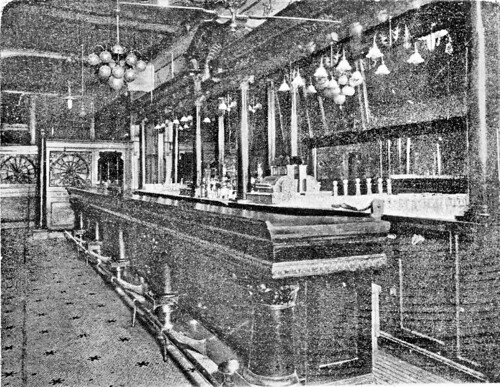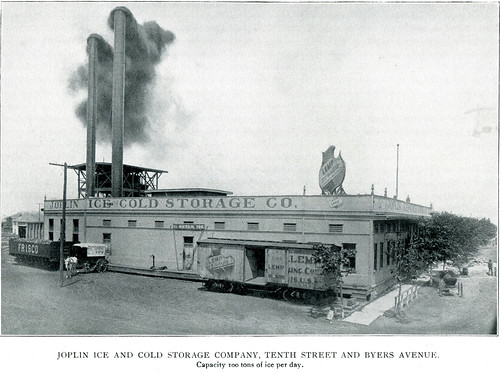Thankfully, Halloween has for the most part shifted away from the “trick” to the “treat” over the last century. In the cartoon below, we catch a glimpse of some of the mischief that Joplin’s young men got up to one Halloween many years ago.
Our Man in Havana
Joplin’s dapper James H. “Jimmy” Worth, owner of Joplin’s famed Worth Block, traveled to Havana, Cuba, and wrote the following letter to his friend E.R. McCullum that was published in a Joplin newspaper:
“Friend Mack: I am well at the time and hope this will find you the same, although I am tired of seeing the prettiest country in the world. I have been most favorably impressed with the cleanliness of the city and the salubrity of its climate. Having visited nearly all the cities in the United States and Canada, I believe I am conversant with municipal conditions in all of them, but I have never see any place that would compare with Havana. I have been in every direction and found the sanitary conditions excellent. It has surprised because of its novelty.
The courteous conduct of the people is another eye-opener. I do not speak Spanish very well and expected to be embarrassed most of the time while I was here, but the innate helpfulness of the native population put me at my ease whenever a difficulty arose. I was dining at a Spanish restaurant the other night and would have had difficulty in ordering my meal had not a Cuban sitting at another table noticed my predicament and voluntarily came to my assistance.
The modern equipment of the financial institutions here are a revelation to all visitors from the states. They have a bright future. I went out and saw the old Spanish forts and visited the negro schools and attended the courts, and was greatly amazed at the thoroughness with which everything is being done here. I haven’t time to write more now, but will follow this with another. My regards to the boys.
JH Worth.”
Men and Dust
In a previous post, we covered Secretary of Labor Frances Perkins’ visit to Joplin in 1940. The reason for Perkins’ visit was to participate in the Tri-State Silicosis Conference, a gathering of industry and labor leaders to investigate and highlight the danger of silicosis. At the conclusion of the conference, a brief documentary film simply titled Men and Dust was shown in the Connor Hotel. The film was produced by the noted Great Depression era photographer Sheldon Dick. Only sixteen minutes long, the film focused on the the danger posed by silicosis generated by the dust created by lead and zinc mining. Dick’s film is surprisingly experimental with a unsettling score and a dramatic narration that has a jarring effect on the viewer. It is an important piece of Joplin’s history because of its haunting advocacy for the welfare of the region’s miners and their families and its stark images of the men who worked the Tri-State Mining District during the Depression era.
We encourage everyone to view it who has a chance.
More on the Early Joplin Black Community
In 1915, Theodore Baughman, a correspondent with the African-American newspaper Topeka Plaindealer, wrote a brief, but detailed account of Joplin’s black community. Baughman observed that although there were less than a thousand African-Americans in Joplin, there were four black churches, and a number of fraternal organizations, though, he noted, none of them had their own meeting hall.
Baughman disappointedly observed that the black community in Joplin was not “given very much to commercialism.” Still, in the paragraphs that followed, he wrote about a few entrepreneurial souls who sought to make a
P. Fred Romare, the “harness king” of Joplin, was born December 8, 1858 (according to a 1920 passport application) or in 1860 (according to his Missouri death certificate), in Chester, South Carolina.* His father, Paul Romare, was a native of Sweden who worked as a bank clerk in Chester. It was there that he fathered Fred with an African-American woman named Esther. When the Civil War broke out, Paul Romare enlisted in the Confederate Army, and served the duration of the war. After the war ended, he moved to Atlanta, Georgia, married a white woman, and eventually became the president of the Atlanta National Bank. He left his mulatto son, P. Fred Romare, behind in South Carolina.
Between 1880 and 1910, P. Fred Romare and his wife Rosa moved to Joplin, Missouri, from South Carolina for reasons still unknown. As a youth, he worked as a carriage maker, and he continued this trade in Joplin. Romare became well known for his wide selection of carriages, buggies, and harnesses. He housed his business in a handsome two story brick building located at 818 Main Street and employed three white men as harness makers. Romare lived at 1826 Pearl until his death on October 20, 1934.
Baughman also called on the Reverend J.N. Brownlee at his real estate office at 521 ½ Virginia Avenue. Brownlee was fortunate to still be alive after he became embroiled in a scandal in 1912 that raised the ire of Joplin’s white community, and led to threats of lynching. According to one newspaper account, young white girls allegedly would meet at Brownlee’s office to drink brandy, beer, and wine. One young white woman, Pearl Nugent, a seventeen-year-old stenographer employed by Brownlee, was found dead in Brownlee’s office. The coroner’s jury ruled she committed suicide by drinking carbolic acid.
Fortunately for Brownlee, attorney John Castillo produced letters that showed Nugent had allegedly been assaulted by a married white man named Walter Bishop from Chitwood, and that she may have committed suicide as a result. The coroner’s jury, in the course of its investigation of Nugent’s death, raised questions about Brownlee’s habit of employing young white women in his office, his lewd treatment of his employees, and his alleged attempt to blackmail the man accused of assaulting Pearl Nugent. Scared of a repeat of the events of 1903, when Thomas Gilyard was lynched in downtown Joplin, many black residents began leaving the city, though one paper noted it was mainly the “shiftless class” that left. The paper added, “No mob plays will be tolerated by the police, however, and the blacks will be protected if there is any hint of uprising.” Joplin Police Chief Joseph Myers warned it was against the law to incite mob violence and that he would not hesitate to stop talk of lynching Brownlee with force.
In an indication of the limited opportunity for black men in Joplin at the time, many of Baughman’s “success” stories were men who worked as janitors at Joplin’s leading businesses. Benjamin Davis worked at Aldridge’s, Arthur Young and Frank Caldwell both worked as janitors at Miner’s Bank, and Joseph Stover was the head janitor at the Keystone Hotel. Although today many may not think that working as a postal carrier a prestigious job, Baughman considered it one for African-American men during this time and N.T. Green, one such gentleman, Baughman wrote, “is one of Uncle Sam’s trusty men.” There were also enough African-Americans in Joplin to keep Dr. J.T. Williams busy after he graduated in 1908 from Meharry Medical College, a historically black medical school in Tennessee.
The Turf Bar, which one will find mentioned in the pages of the Joplin newspapers, was possibly owned by George Lindsay. The Turf was located at 123 Main Street and served Budweiser, Middle West, and Falstaff beer. In 1914, under a different owner, it was considered one of the finest bars in Joplin. J.W. Brown’s People’s Café was located just down the way at 109 Main Street
While turn of the century Joplin was a bustling growing city, it was also a city that limited the many opportunities available to the color of one’s skin. Joplin’s early African-American residents none the less persevered to the best of their abilities to build a life for themselves and their families in Southwest Missouri.
Afternote:
The African-American artist, Romare Bearden, was named after P. Fred Romare, who was a friend of his great-grandparents. He stated in an oral history that the name was pronounced, “ROAM-a-ree.”









